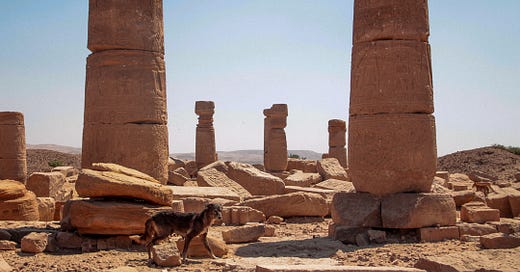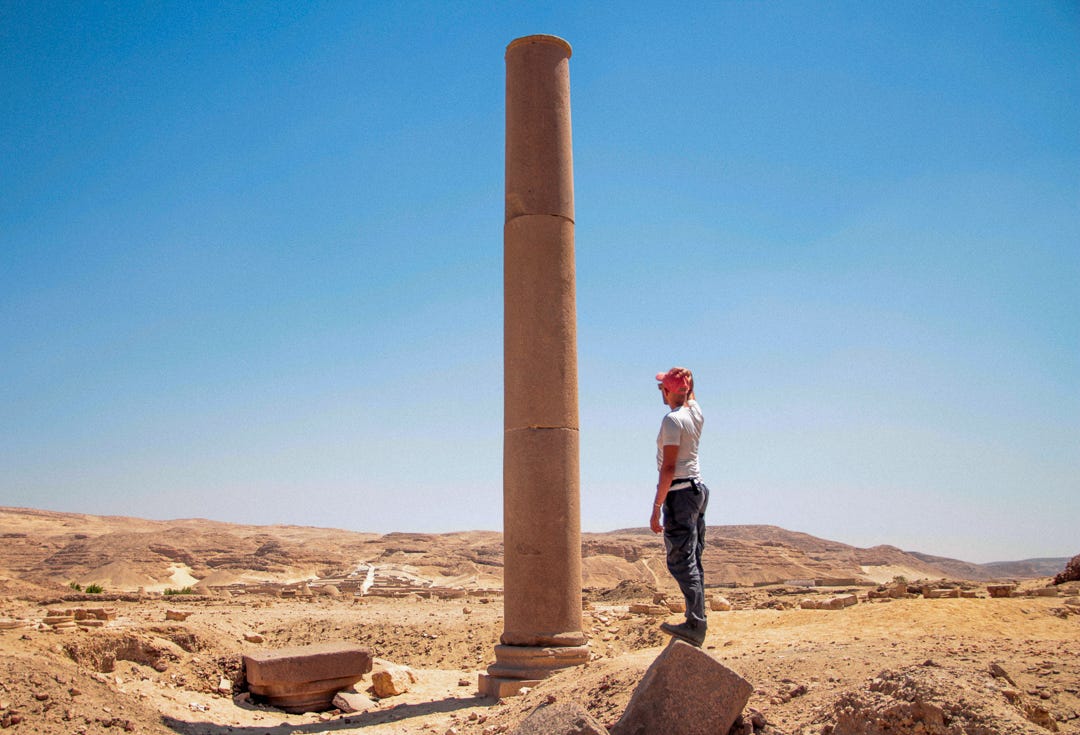What makes a love story eternal? Ancient love stories have a certain je ne sais quoi, perhaps because they've survived the sands of time, proving their enduring allure. A common denominator in the greatest love stories is the early demise of one or both lovers, which imparts an immortal, melancholic quality that a life of domesticity, child-rearing, and growing old simply can't offer.
My first encounter with a legendary couple happened in London. In the British Museum, stood two white marble busts side by side. Hadrian, one of the great Roman emperors, looked solid and sturdy, with wavy hair and a beard, staring at you in a firm yet tender way. Antinous, on the other hand, had flowing hairlocks, smooth facial angles, and a sculpted chest—a prominent ‘twunk’. These busts, like many arefacts in the museum, were obtained through the British Empire’s reach. Archaeology is one arm of such power, not only in extraction but the interpretation of ancient relationships. But I digress. Back to love.
We don't know how they met. Antinous was famously gorgeous, born in Asia Minor. One story goes that Hadrian had his entourage search the empire for the most beautiful twink. The selection process remains a mystery. Antinous was elevated to favourite status and soon accompanied Hadrian on adventurous trips around the empire. One can't help but notice the age gap between the men, which might compel us to describe it as pedophilic, or the older word, pederastic. Others may argue against imposing modern perspectives on ancient relationships. How Antinous felt about the affair remains unknown.
The tragic climax of their love story happened in Egypt, where Antinous drowned in the Nile. The mystery surrounding his death has sparked various theories, one being a sacrificial ritual coinciding with the Nile festival. Did Hadrian know about it? We don't know. Another theory blames a spiteful wife, but that sounds like a misogynist cliché. One thing is sure: Hadrian was devastated. He wept publicly and ordered a city to be built on the site of Antinous's death. Antinous's face graced Roman coins, and his bust appeared all over the empire because he was deified. He inspired authors, symbolizing tragic love, illicit debauchery, and despotic slavery.
The city, Antinopolis, used to stand about 20 kilometres south of where I was born, but I needed to travel to London to learn the story. The memory of why it was established was essentially erased. At least in the local environment. Abroad, where a homophobile culture legendised the love story, the story found broad appeal. A TV show is coming soon based on the famous novel Memoirs of Hadrian.
Last summer, I visited the site. A dream I have been chasing since the London museum visit about 15 years ago. Heaps of ruins are all that remain of the city—a column—a phallic figure protruding like a relic from ancient times. A guard approached, indignant, inquiring who I was and what my business there was, his hand on his gun.
Without delving too much into Egypt’s chaotic, nonsensical, and hyper-securitized treatment of their neglect of ancient site—especially in the region where I grew up, a largely marginalized and impoverished province that reeled under violent terror groups in the '90s. Antinopolis (currently a village called Elsheikh Ebada) has no proper access, explanatory signs —the funny part was when I finally met a tour guide who only spoke about Antinopolis’s history in Egyptian code. This means making references without explicitly saying anything about it. I think, for some reason, he assumed that I already knew the story. I find it fascinating how much can be said and inferred in Egyptian communication without spelling it out.
30 kilometres in the other direction, north of my hometown, another ancient love story blossomed and was nipped in the bud. This affair unfolded during the reign of the subsequent Roman emperor, a few years after Hadrian's death, in the 2nd century, usually dubbed the Greco-Roman era of Egypt, and ancient Egyptian civilization was considered ancient even to them.
Isadora was a beautiful girl and the educated daughter of the local governor. Her lover, Hapi, was an Egyptian commoner. They met at another ancient festival, which might make it sound as if life was a constant rave at that time. The wealthy girl couldn't be with the poor boy. Isadora killed herself because she couldn't have her lover. The story goes that she crossed the Nile in a boat to meet him one last time and drowned herself on the way back. A moving eulogy written by her father can be read in the gorgeous tomb he constructed for her, lamenting her fate—too late, I suppose.
Does this sound familiar? Have you seen this movie before? Love across and despite social differences is the kind of adversity that imparts these stories with an enduring quality. In this sense, Titanic archives immortality because it is about class differences and Jack’s frozen death at the end—a dual recipe.
Power differences manifest in various shapes and forms in relatiosnhps: interracial, intergenerational, or interclass. Unlike Hadrian and Antinos, where age was the main difference in the relationship, Isadora and Hapi had to contend with another set of challenges. Interestingly, heterosexual love itself spans the gender divide. By contemporary standards, this relationship can be seen as interracial (a Greek and an Egyptian), interclass (social strata), and unequivocally heterosexual.
Unlike the site of Antinous’s death, which remained unknown to me while I lived in Egypt, I had visited Isadora's tomb a few times in my younger years. The tomb of Isadora is widely known. Her mummy lies there, a body that survived 2,000 years, venerated as a ‘the martyr of love.’ Women from nearby villages still come to seek blessings from her, especially those wanting to increase their chances of fertility. They practice lying and rolling down the sand dune to open themselves to love. The legend lives, but will it survive the encroaching modernity?
So you see, my dear reader, many factors make a love story eternal. The two stories come from the same time and place. Same-sex desire is part of why one is well-known and the other isn’t. The usual suspects: age, race, class, and sexual orientation could either make the relationship more or less spicy, make people want to erase the narrative deliberately, or just simply misread and misunderstand it. Then there's the question of who writes the story and who can relate to and identify with it. Who will legendise which narrative and how does it play on audience sensibilities. An ancient love story could become adopted locally or travel internationally.
Finally, we can't forget the role of death rituals and how much the bereaved makes a spectacle of the loss. If your lover doesn’t build a city in your name and put your face on banknotes, you know it’s not real.
if you made it this far, please show some support and consider sharing <3









